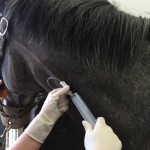Sure you would! The flat side has a greater weight-bearing surface than the edge, so it will cause you a lot less pain to press that on your hand than to push the sharp edge down.
With this in mind, you’d be forgiven for assuming that a thicker bit will always be a milder option for your horse as the greater weight bearing surface of a thick bit in comparison to a thinner bit should provide more comfort for the horse as you apply pressure through your reins.
But is thicker always kinder?
The inner specs of the equine mouth need to be taken into consideration, and a horse’s tongue fills the whole of the oral cavity when the mouth is closed. Fortunately, the tongue is a flexible muscle so when we put a bit in the mouth we compress the tongue slightly, creating space by drawing it away from the hard, bony structure that creates the upper palate and encouraging the horse to relax the tongue down onto the floor of the mouth.
While we have established that a large weight bearing surface is going to be milder in relation to the forces we put on the tongue through the reins, we need to consider the other effects that a thick bit might have on the mouth. If the bit is too thick, the horse may struggle to close their mouth around the bit comfortably, without causing damage to the unforgiving upper palate.
If the bit is causing pressure between the sensitive bars of the mouth, or on the upper palate the horse is likely to open their mouth to avoid the discomfort, and what happens then? We strap the mouth shut with a flash noseband! So the pressure has increased further and it’s now unavoidable.
















